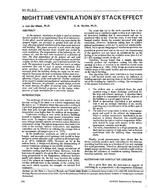
NY-91-05-3 — Nighttime Ventilation by Stack Effect
- Comments Off on NY-91-05-3 — Nighttime Ventilation by Stack Effect
- ASHRAE
In the summer, ventilation at night is used to increase thermal comfort in an experimental three-level laboratory. To this effect, special apertures, which stay open during the summer nights, are provided at ground level and on the roof, allowing natural ventilation of the high-mass staircase and building. This paper concerns a case where the high-mass staircase (all internal doors closed) was cooled by stack ventilation. The temperatures of the inflowing air, the exhaust air, and the wall were measured as a function of time. The time dependence of the exhaust air and wall temperatures is compared with a simple dynamic model that couples air flow, heat transfer, and a thermal model for the wall. The agreement is good. The heat loss rate is an output parameter that can be used in energy calculations. For given openings, the model predicts that the total heat extracted from the building during the night can be maximised by increasing the heat-exchanging surface area (e.g., all internal doors open) and by increasing the thermal effusivity, of the wall materials. Further validation of the model is needed and mechanical ventilation should be included. However, in principle, a simple design tool can be made showing the effect of opening sizes, wall surface area, and wall thermal properties on the energy consequences of night ventilation for a particular climate.
KEYWORDS: nighttime, ventilation, laboratories, stack effect, summer, thermal comfort, experiment, natural ventilation, stairs, stack ventilation, comparing, heat loss, algorithms, climate, nighttime cooling.
Citation: Symposium, ASHRAE Transactions, vol.97, Pt. 1, New York 1991
Product Details
- Published:
- 1991
- Number of Pages:
- 9
- File Size:
- 1 file , 1.2 MB
- Product Code(s):
- D-18572

